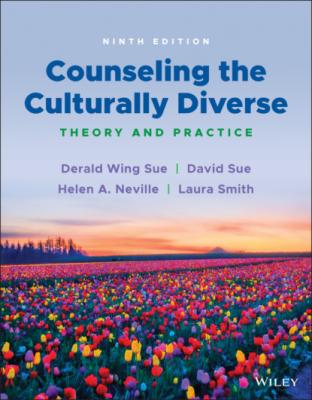ТОП просматриваемых книг сайта:
Counseling the Culturally Diverse. Laura Smith L.
Читать онлайн.Название Counseling the Culturally Diverse
Год выпуска 0
isbn 9781119861911
Автор произведения Laura Smith L.
Жанр Психотерапия и консультирование
Издательство John Wiley & Sons Limited
IMPLICATIONS FOR CLINICAL PRACTICE
1 Listen and be open to stories of those most disempowered in U.S. society. Counseling has always been about listening to our clients. Do not allow your emotional reactions to negate their voices because you become defensive.
2 Know that although you were not born wanting to be racist, sexist, or heterosexist, or to be prejudiced against any other group, your cultural conditioning has imbued certain biases and prejudices in you. No person or group is free from inheriting the biases of U.S. society.
3 Understand and acknowledge your intense emotions and what they mean for you. CCD speaks about unfairness, racism, sexism, and prejudice, making some feel accused and blamed. The “isms” of our society are not pleasant topics, and we often feel unfairly accused.
4 It is important that helping professionals understand how they may still benefit from the past actions of their predecessors and continue to reap the benefits of the present social/educational arrangements.
5 Understand that multicultural training requires more than book learning. In your journey to developing cultural competence, it is necessary to supplement your intellectual development with experiential reality.
6 Do not be afraid to explore yourself as a racial, ethnic, and cultural being. An overwhelming number of mental health practitioners believe they are good, decent, and moral people. Because most of us would not intentionally discriminate, we often find great difficulty in realizing that our belief systems and actions may have oppressed others.
7 Open dialogue—to discuss and work through differences in thoughts, beliefs, and values—is crucial to becoming culturally competent. It is healthy when we are allowed to engage in free dialogue with one another. To a large extent, unspoken thoughts and feelings serve as barriers to open and honest dialogue about the pain of discrimination and how each and every one of us perpetuates bias through our silence or obliviousness.
8 Finally, continue to use these suggestions in reading throughout the text. What emotions or feelings are you experiencing? Where are they coming from? Are they blocking your understanding of the material? What do these reactions mean for you personally and as a helping professional?
Microtraining Series Video: Emotional Roadblocks to Counseling the Culturally Diverse
SUMMARY
Students who take a course on multicultural counseling and mental health issues have almost universally felt both positive and negative feelings that affect their ability to learn about diversity issues. Those from marginalized groups often feel validated by the content while majority group members often feel a range of emotions like defensiveness, anxiety, anger, and guilt. It is important not to allow these nested or embedded emotions to go unacknowledged, or to avoid exploring the psychological meanings they may have for trainees. The journey to becoming culturally competent therapists is filled with obstacles to self‐exploration, to understanding oneself as a racial/cultural being, and to understanding the worldview of those who differ from others in terms of race, gender, ethnicity, sexual orientation, and other sociodemographic dimensions. The subject matter in this book requires students to explore their biases and prejudices, a task that often evokes strong resistance from both majority and oppressed group members.
It is important to recognize personal resistance to the material, to explore its meaning, and to learn about yourself and others. Sometimes, what is revealed about you may prove disturbing, but having the courage to continue is necessary to becoming a culturally competent counselor or therapist. Recognizing the manifestation and hidden meanings of resistance is one of the first priorities of multicultural training for both trainees and trainers. For trainees, it is finding the courage to confront their own fears and apprehensions, to work through the powerful emotions they are likely to experience, to explore what these feelings mean for them as racial/cultural beings, to achieve new insights about themselves, and to develop multicultural skills and behaviors in their personal lives and as mental health professionals. For trainers, it means understanding the nature of trainee resistance, creating a safe but challenging environment for self‐exploration, and using intervention strategies that facilitate difficult dialogues on race, gender, sexual orientation, and other sociodemographic dimensions. This chapter is specifically written to help readers understand and overcome their emotive reactions to the substance of the text and the course they are about to take.
GLOSSARY TERMS
Behavioral resistance (to multicultural education)
Cognitive resistance (to multicultural education)
Emotional resistance (to multicultural education)
REFERENCES
1 American Psychological Association. (2017). Multicultural guidelines: An ecological approach to context, identity, and intersectionality. Retrieved from http://www.apa.org/about/policy/multicultural‐guidelines.pdf
2 American Psychological Association (APA) Presidential Task Force on Preventing Discrimination and Promoting Diversity. (2012). Dual pathways to a better America: Preventing discrimination and promoting diversity. Washington, DC: American Psychological Association.
3 Apfelbaum, E. P., Sommers, S. R., & Norton, M. I. (2008). Seeing race and seeming racist: Evaluating strategic colorblindness in social interaction. Journal of Personality and Social Psychology, 95, 918–932.
4 Appiah, O., Eveland, W. P., Bullock, O. M., & Coduto, K. D. (2021). Why we can't talk openly about race: The impact of race and partisanship on respondents’ perceptions of intergroup conversations. Group Processes and Intergroup Relations, 19, 1–19.
5 Bell, L. A. (2002). Sincere fictions: The pedagogical challenges of preparing White teachers for multicultural classrooms. Equity and Excellence in Education, 35, 236–244.
6 Bolgatz, J. (2005). Talking race in the classroom. New York, NY: Educators College Press.
7 Bonilla‐Silva, E. (2006). Racism without racists: Color‐blind racism and the persistence of racial inequality in the United States.

